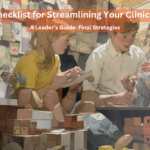The complexity of clinical trials can feel as daunting as the first time you held a Rubik’s Cube in your hand. Unlike removing the colored stickers to match, you don’t have to cheat to streamline your clinical trials. Here we provide you with a secret weapon… the ultimate checklist of 8 actionable processes that you can start now to streamline in 2024. In this 2-part series, we uncover the first 4 items you need to prioritize… budget, technology, patient recruitment, and regulatory affairs so let’s dive right in with your roadmap to success.

1. Budgeting Brilliance: The Foundation of Successful Clinical Trials
Before diving into the nitty-gritty of clinical trials, let’s talk money – specifically, how it’s allocated. Smart budgeting is the bedrock of efficient and effective clinical trials, but it’s not just about how much you spend; it’s about how wisely you spend it.
Known for their strategic investments in drug development, Novartis invested approximately $9 billion in R&D in 2020, as reported by their financial statements. This investment demonstrates a serious commitment to innovation on their part, particularly in prioritizing projects with the potential to address medical needs that are currently significantly unmet.
Similarly, Johnson & Johnson has been a model for strategic R&D investment. In 2021, they reported an R&D spending of $14.7 billion. This funding isn’t just thrown at every project that comes their way. Instead, Johnson & Johnson carefully selects projects based on their potential impact, focusing on areas like oncology, immunology, and neuroscience. This strategic approach makes sure that the return on this investment leads to meaningful advances in medicine and healthcare.
As a leader, your role in budgeting goes beyond just signing checks. It involves a careful balancing act between the endless possibilities of medical research against the constraints of your budget, which will require a solid understanding of both the potential of a project and the market needs it aims to resolve. By applying similar strategies used by Novartis and Johnson & Johnson, you can also ensure that your investment dollars are not only advancing scientific medical knowledge but are also bringing tangible health benefits to society.

2. Embrace Technology: The Digital Wizardry
By integrating tools like AI and advanced data analytics, like Dorothy from the Wizard of OZ, we are not in Kansas anymore. Drug development and clinical trials can now follow the yellow brick road of technology to open new and exciting ways to accelerate treatment to patients.
For instance, AstraZeneca has been at the forefront of incorporating artificial intelligence in drug discovery and development and has partnered with AI technology companies like Absci to design an antibody to fight cancer. These collaborations enhance the efficiency of drug discovery process by using AI algorithms to analyze complex biological datasets and identify potential drug candidates more quickly than previously. This approach not only speeds up the discovery process, but it also increases the accuracy of identifying viable drug candidates.
Similarly, GlaxoSmithKline (GSK) has embraced digital technology to transform their clinical trials. GSK collaborated with AI-driven companies like Tempus to improve the design and execution of clinical trials. By using AI to analyze medical data, GSK can more accurately predict patient enrollment rates, enhance patient selection criteria, and identify potential challenges in trial protocols. This has allowed GSK to have more efficient trials, reduce time and costs while enhancing the quality of their clinical trial outcomes.
Embracing digital wizardry means staying ahead of the curve. It’s about understanding and integrating technologies such as AI, machine learning, and advanced analytics into every phase of clinical trials. By integrating advancing technology not only does it streamline the process, but it also opens new avenues for innovation in drug development, making clinical trials faster and considerably more efficient while still maintaining a high degree of patient-centricity.

3. Patient Recruitment: Getting It Right from The Start
Finding and enrolling the right patients can be like searching for a needle in a haystack. Innovative recruitment strategies are essential to ensure success and the validity of your trials. Success will require a targeted recruitment strategy that leverages social media, patient databases, and collaboration with healthcare providers.
One noteworthy example comes from Bristol Myers Squibb (BMS). BMS has been somewhat of a pioneer in leveraging digital platforms and patient networks for recruitment. By using advanced analytics to sift through patient data and electronic health records, they can identify potential candidates who match the trial inclusion criteria. This method not only speeds up the recruitment process but also enhances the accuracy and relevance of their clinical trial cohorts.
Not to be outdone, Eli Lilly has adopted a patient-centric recruitment strategy, focusing on enhancing the patient’s experience. Since 2016 they have utilized digital tools and social media platforms not just for outreach but also to educate and engage potential participants. By creating awareness and understanding around their trials, they’re able to attract and more importantly, retain more suitable candidates.
These strategies really demonstrate an important shift in clinical trials – away from traditional, broad recruitment methods to a more focused, tech-enabled, patient-centric approach. The right recruitment strategy should be a mixture of leveraging technology, such as social media and electronic health records, and fostering strong relationships and collaborations with healthcare providers and patient advocacy groups. This holistic approach is not a guarantee, but it offers the best way to create connections with potential participants, understand their needs and concerns, and ensure that they are the right fit for the trial from the start.

4. Regulatory Navigation: Steering Through Bureaucratic Waters
Navigating regulatory waters is like navigating a maze, where staying updated with the latest guidelines and maintaining a constructive dialogue with regulatory bodies are key. This isn’t just about compliance; it’s about fostering a collaborative relationship with authorities like the FDA or EMA to ensure smooth sailing with the trial.
Set a high standard for this process by recognizing and understanding the dynamic nature of the regulatory landscape and dedicate teams that can closely monitor regulatory changes across different regions. Ensure that your teams are proactive and have conversations early in the process with the appropriate regulatory individuals, to ensure the trial designs meet both the standards and guidelines necessary to avoid troubled waters. This will not only streamline the approval process but minimize delays due to regulatory hurdles.
Sanofi who ensures that their clinical trials are designed with regulatory requirements in mind from the outset is a great example of this. They frequently engage with regulatory bodies to gain early insights into potential compliance issues before they become hurdles, thereby enhancing the likelihood of successful trial outcomes.
Understanding the intricacies of regulatory requirements and including this level of understanding in each stage of the clinical trial process means building and maintaining strong regulatory teams. Successful navigation looks like this: constant vigilance, adaptability, and open lines of communication with these regulatory folks, and as a leader, you can ensure that your trials not only comply with regulatory standards but are successful by adopting these practices.
Stay tuned for the next installment, where we unveil 4 more advanced strategies that are reshaping how the industry approaches everything from protocol design to leveraging global partnerships to bring an innovative edge to your clinical trials to make them not merely successful, but exemplary.









